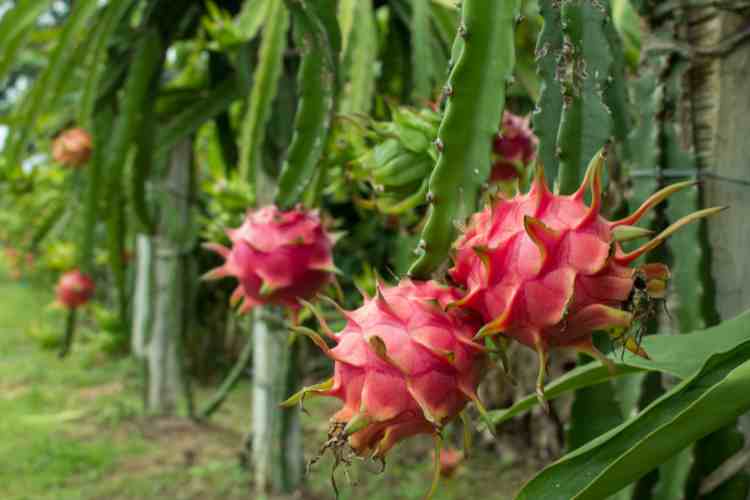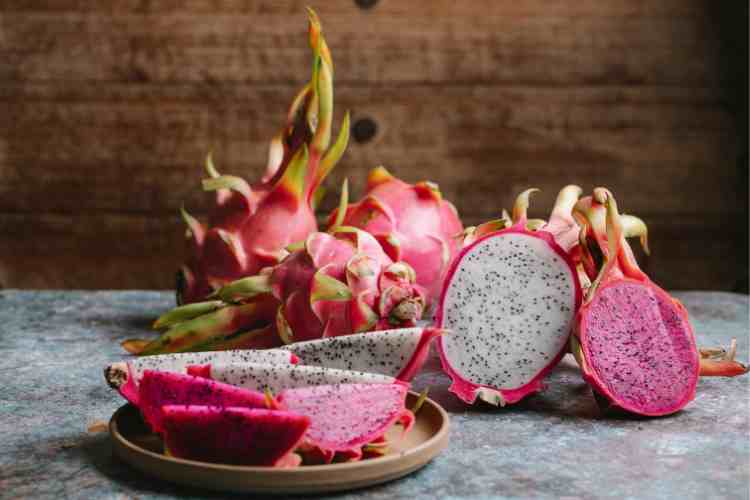Last Updated on August 6, 2024
Dragon Fruit Fruit: A Comprehensive Guide to the Exotic Delight
Have you ever been captivated by the exotic allure of dragon fruit fruit? This vibrant, tropical fruit not only dazzles with its striking appearance but also packs a powerful punch of nutrients and health benefits. Whether you’re a seasoned dragon fruit fan or new to this unique fruit, you’ll find everything you need to know right here.
What is Dragon Fruit?
Dragon fruit, also known as pitaya, comes from the cactus family and is native to Central America. There are two main types: Hylocereus, which is more common, and Selenicereus. The fruit is typically oval or pear-shaped, with a bright pink or yellow skin and white or red flesh speckled with tiny black seeds. Its texture is often compared to kiwi or pear.
Nutritional Composition of Dragon Fruit
Dragon fruit is a nutritional powerhouse, offering a range of vitamins and minerals:
- Vitamins and Minerals:
- Vitamin C
- Vitamin B1 (Thiamine)
- Vitamin B2 (Riboflavin)
- Vitamin B3 (Niacin)
- Iron
- Magnesium
- Phosphorus
- Calcium
- Nutrient Breakdown:
- Calories: 60 per 100 grams
- Carbohydrates: 13 grams
- Fiber: 3 grams
- Protein: 1.2 grams
- Fat: 0.5 grams

Health Benefits of Dragon Fruit Fruit
Rich in Antioxidants
Dragon fruit is loaded with antioxidants like flavonoids, phenolic acid, and betacyanin, which help protect your cells from damage by free radicals. These antioxidants are essential for reducing inflammation and preventing chronic diseases.
High Fiber Content
The fruit’s high fiber content aids in digestion, prevents constipation, and promotes a healthy gut microbiome. Fiber is crucial for maintaining a healthy digestive system and can help prevent conditions like irritable bowel syndrome (IBS) and diverticulosis.
Boosts Immune System
With a significant amount of vitamin C, dragon fruit can enhance your immune system, helping your body fend off infections. Vitamin C is also vital for the production of collagen, which is necessary for healthy skin, cartilage, and bones.
Promotes Gut Health
Dragon fruit contains prebiotics, which nourish the good bacteria in your gut, promoting a healthy digestive system. Prebiotics help maintain a balance of beneficial bacteria, which is essential for overall health and well-being.
Good for Skin and Hair
The vitamins and antioxidants in dragon fruit can improve skin health, giving you a natural glow, and strengthen hair follicles, reducing hair fall. Regular consumption can help combat signs of aging and keep your skin looking youthful.
How to Grow Dragon Fruit
Growing dragon fruit can be a rewarding experience. Here’s a detailed guide to help you cultivate this exotic fruit.
Ideal Climate and Soil Conditions
Dragon fruit thrives in warm, humid climates and well-draining soil. It’s best suited for USDA zones 10-11. Ensure the soil has good organic content and is slightly acidic to neutral (pH 6-7).
Planting Tips
- Seeds: Plant seeds in a well-draining soil mix. Keep the soil moist and ensure it receives plenty of sunlight. Germination can take 1-2 weeks.
- Cuttings: Cut a segment of the cactus vine and let it dry for a few days. Plant it in a well-draining soil mix and water sparingly until roots develop. Cuttings can take root faster than seeds and often produce fruit sooner.
Watering and Fertilizing
Dragon fruit requires moderate watering. Overwatering can lead to root rot. Water the plants when the topsoil feels dry, and ensure proper drainage. Fertilize with a balanced, cactus-specific fertilizer every couple of months, particularly during the growing season.
Common Pests and Diseases
Watch out for pests like aphids, mealybugs, and spider mites. Regularly inspect your plants and use organic pest control methods, such as neem oil, if needed. Ensure good air circulation around the plants to prevent fungal diseases like anthracnose and stem rot.
How to Harvest and Store Dragon Fruit Fruit
Harvesting dragon fruit at the right time ensures the best flavor and texture.
Signs of Ripeness
Harvest dragon fruit when the skin is bright yellow or pink and it gives slightly under pressure. Dragon fruit buds form on cactus vines and are ready to harvest when their flesh is yellow or pink. Reference
Proper Harvesting Techniques
Use a sharp knife or scissors to cut the fruit from the vine, leaving a small portion of the stem attached. Handle the fruit gently to avoid bruising.
Storage Tips
Store dragon fruit in the refrigerator for up to a week. For longer storage, you can freeze the flesh in an airtight container. Freezing dragon fruit retains most of its nutrients and is great for making smoothies.

Culinary Uses of Dragon Fruit
Dragon fruit is as versatile as it is delicious. Here are some ideas to incorporate it into your meals.
How to Prepare and Eat Dragon Fruit
- Slice the fruit in half and scoop out the flesh with a spoon.
- Cut it into cubes or slices to add to fruit salads, smoothies, or desserts.
- Blend the flesh to make a refreshing juice or smoothie base.
Popular Recipes
- Dragon Fruit Smoothie: Blend dragon fruit with banana, yogurt, and a splash of coconut water for a tropical treat.
- Dragon Fruit Salad: Mix cubed dragon fruit with other tropical fruits like mango and pineapple, and drizzle with lime juice for a refreshing salad.
- Dragon Fruit Sorbet: Puree the flesh and freeze it with a bit of honey and lemon juice for a healthy dessert.
Pairing Suggestions
Dragon fruit pairs well with other tropical fruits, yogurt, coconut, and even spicy flavors like chili and lime. Try adding it to your breakfast bowls, desserts, or even cocktails for a vibrant twist.
Interesting Facts About Dragon Fruit Fruit
Dragon fruit is not just a treat for the taste buds; it has a fascinating background and cultural significance.
Historical Significance and Origin
Dragon fruit originated in Central America but is now grown worldwide in tropical and subtropical regions. The fruit was introduced to Asia by French missionaries in the early 19th century and has since become a staple in many Asian cuisines.

Symbolism and Cultural References of Dragon Fruit Fruit
In some cultures, dragon fruit symbolizes prosperity and luck. It is often used in festive occasions and religious offerings due to its vibrant color and unique appearance.
Fun Trivia
- The flower of the dragon fruit cactus blooms only at night and is often called the “moonflower” or “queen of the night.”
- Despite its exotic appearance, dragon fruit is relatively easy to grow and maintain, making it a popular choice for home gardeners.
Conclusion
Dragon fruit is not just a beautiful and exotic fruit but also a nutritional powerhouse with numerous health benefits. Whether you’re growing it in your garden or enjoying it in a smoothie, dragon fruit is a delicious and versatile addition to your diet. Give it a try and discover the many ways it can enhance your culinary adventures and health.


